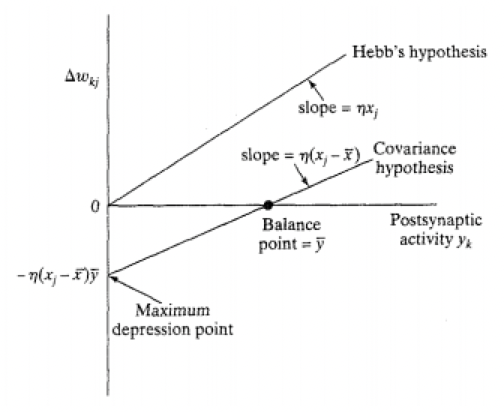Time-dependent, highly local, strongly interactive
- Oldest learning algorithm
- Increases synaptic efficiency as a function of the correlation between presynaptic and postsynaptic activities
- If two neurons on either side of a synapse are activated simultaneously/synchronously, then the strength of that synapse is selectively increased
- If two neurons on either side of a synapse are activated asynchronously, then that synapse is selectively weakened or eliminated
- Hebbian synapse
- Time-dependent
- Depends on times of pre/post-synaptic signals
- Local
- Interactive
- Depends on both sides of synapse
- True interaction between pre/post-synaptic signals
- Cannot make prediction from either one by itself
- Conjunctional or correlational
- Based on conjunction of pre/post-synaptic signals
- Conjunctional synapse
- Time-dependent
- Modification classifications
- Hebbian
- Increases strength with positively correlated pre/post-synaptic signals
- Decreases strength with negatively correlated pre/post-synaptic signals
- Anti-Hebbian
- Decreases strength with positively correlated pre/post-synaptic signals
- Increases strength with negatively correlated pre/post-synaptic signals
- Still Hebbian in nature, not in function
- Non-Hebbian
- Doesn’t involve above correlations/time dependence etc
- Hebbian
Mathematically
- Generally
- All Hebbian

Hebb’s Hypothesis
- Activity product rule
- Exponential growth until saturation
- No information stored
- Selectivity lost
Covariance Hypothesis
- Characterised by perturbation from of pre/post-synaptic signals from their mean over a given time interval
- Average and constitute thresholds
- Intercept at y = y bar
- Similar to learning in the hippocampus
Allows:
- Convergence to non-trivial state
- When x = x bar or y = y bar
- Prediction of both synaptic potentiation and synaptic depression